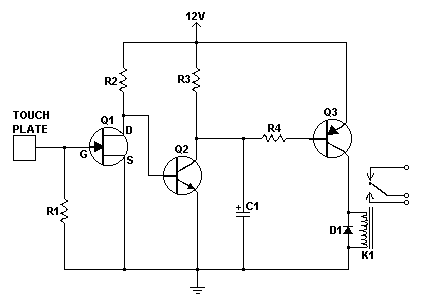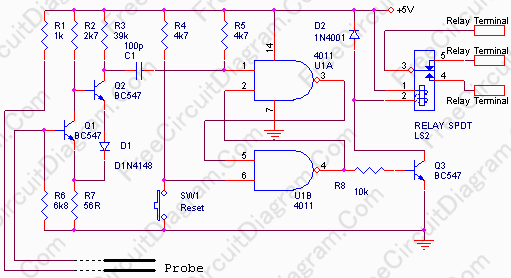
LM339D Simple Capacitive Touch Sensor

This circuit is utilized for proximity detection and touch-controlled switching. When a finger approaches the sensor, it generates a capacitance to ground with a value ranging from 30 to 100 pF. Components involved include a resistor, capacitor, diode, and the LM339D integrated circuit.
The proximity detection circuit operates by measuring variations in capacitance caused by the presence of nearby objects, such as a human finger. The LM339D, which is a quad comparator, plays a crucial role in processing the signals generated by the sensor. The capacitive sensing mechanism works by detecting changes in the capacitance between the sensor and the ground, which occurs when a conductive object, like a finger, comes close.
In this configuration, the capacitor is typically connected in parallel with the sensor to stabilize the readings and filter out noise. The resistor is used to set the sensitivity of the circuit; it can be adjusted to change the threshold at which the comparator triggers. The diode is included to protect the circuit from voltage spikes that may occur during operation.
When the capacitance exceeds a predefined threshold, the LM339D outputs a high signal, which can be used to drive a load or activate another circuit. This makes the design suitable for applications such as touch-sensitive switches, where the user can control devices by simply bringing their finger close to the sensor without making physical contact. Overall, this circuit provides an efficient and reliable method for proximity detection and touch control, leveraging the properties of capacitive sensing technology.Used for proximity detection and touch-controlled switching. for example, a finger comes close to the sensor, it creates a capacitance to Earth with a value of 30 to 100 pF. Component: Resistor, Capacitor, Diode, LM339D IC 🔗 External reference
The proximity detection circuit operates by measuring variations in capacitance caused by the presence of nearby objects, such as a human finger. The LM339D, which is a quad comparator, plays a crucial role in processing the signals generated by the sensor. The capacitive sensing mechanism works by detecting changes in the capacitance between the sensor and the ground, which occurs when a conductive object, like a finger, comes close.
In this configuration, the capacitor is typically connected in parallel with the sensor to stabilize the readings and filter out noise. The resistor is used to set the sensitivity of the circuit; it can be adjusted to change the threshold at which the comparator triggers. The diode is included to protect the circuit from voltage spikes that may occur during operation.
When the capacitance exceeds a predefined threshold, the LM339D outputs a high signal, which can be used to drive a load or activate another circuit. This makes the design suitable for applications such as touch-sensitive switches, where the user can control devices by simply bringing their finger close to the sensor without making physical contact. Overall, this circuit provides an efficient and reliable method for proximity detection and touch control, leveraging the properties of capacitive sensing technology.Used for proximity detection and touch-controlled switching. for example, a finger comes close to the sensor, it creates a capacitance to Earth with a value of 30 to 100 pF. Component: Resistor, Capacitor, Diode, LM339D IC 🔗 External reference





